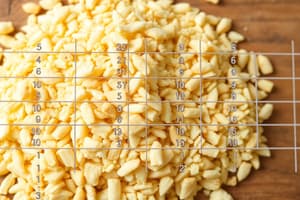Podcast
Questions and Answers
The Weende system of feed analysis, developed in 1865, is no longer used in modern feed evaluation due to its age and limitations.
The Weende system of feed analysis, developed in 1865, is no longer used in modern feed evaluation due to its age and limitations.
False (B)
In proximate analysis, the nitrogen-free extract (NFE) is directly measured in the lab, rather than calculated.
In proximate analysis, the nitrogen-free extract (NFE) is directly measured in the lab, rather than calculated.
False (B)
The Kjeldahl procedure to determine crude protein involves four steps: digestion, neutralization, distillation and titration.
The Kjeldahl procedure to determine crude protein involves four steps: digestion, neutralization, distillation and titration.
False (B)
During the determination of ash content in feedstuffs, all trace elements remain in the residue, providing an accurate representation of the mineral composition.
During the determination of ash content in feedstuffs, all trace elements remain in the residue, providing an accurate representation of the mineral composition.
The detergent system of feed analysis separates plant cells into only digestible cell walls and indigestible cell contents.
The detergent system of feed analysis separates plant cells into only digestible cell walls and indigestible cell contents.
Neutral Detergent Fiber (NDF) is composed of only cellulose and lignin.
Neutral Detergent Fiber (NDF) is composed of only cellulose and lignin.
Ether extract analysis accurately measures only the true fat content in feeds.
Ether extract analysis accurately measures only the true fat content in feeds.
The percentage of nitrogen in proteins is assumed to be 16% when calculating crude protein.
The percentage of nitrogen in proteins is assumed to be 16% when calculating crude protein.
The detergent system of feed analysis was designed by Peter Van Soest and has become one of the most important sets of food assays in ruminant nutrition.
The detergent system of feed analysis was designed by Peter Van Soest and has become one of the most important sets of food assays in ruminant nutrition.
The Weende method for estimating the crude fiber content of foods and feeds is considered a highly accurate and satisfactory method.
The Weende method for estimating the crude fiber content of foods and feeds is considered a highly accurate and satisfactory method.
According to the information, the Van Soest method of fiber analysis is only used for animal nutrition studies related to crude fiber
According to the information, the Van Soest method of fiber analysis is only used for animal nutrition studies related to crude fiber
Gross energy is available for use by animals as some is excreted in urine and faeces, or lost as heat or gases as the feed is digested and metabolized.
Gross energy is available for use by animals as some is excreted in urine and faeces, or lost as heat or gases as the feed is digested and metabolized.
The loss of energy in urine and methane is approximately 30% of DE.
The loss of energy in urine and methane is approximately 30% of DE.
According to the information, ingesting food requires muscular activity by the jaws and by the muscles of the gastro-intestinal tract.
According to the information, ingesting food requires muscular activity by the jaws and by the muscles of the gastro-intestinal tract.
Efficiency of converting ME to NE for energy depends on the breed of animal consuming the feed.
Efficiency of converting ME to NE for energy depends on the breed of animal consuming the feed.
Flashcards
Proximate Analysis
Proximate Analysis
A chemical analysis method to determine animal feed composition.
Dry Matter (DM)
Dry Matter (DM)
Important for reliable measurements of feed constituents.
Crude Protein (CP)
Crude Protein (CP)
Determined using the Kjeldahl procedure, measures total nitrogen.
Crude Ash
Crude Ash
Signup and view all the flashcards
Crude Fibre (CF)
Crude Fibre (CF)
Signup and view all the flashcards
Ether Extract (EE)
Ether Extract (EE)
Signup and view all the flashcards
Nitrogen-Free Extract (NFE)
Nitrogen-Free Extract (NFE)
Signup and view all the flashcards
Detergent Fibre Analysis
Detergent Fibre Analysis
Signup and view all the flashcards
NDF's indicator
NDF's indicator
Signup and view all the flashcards
Acid Detergent Fibre (ADF)
Acid Detergent Fibre (ADF)
Signup and view all the flashcards
Gross Energy (GE)
Gross Energy (GE)
Signup and view all the flashcards
Digestible Energy (DE)
Digestible Energy (DE)
Signup and view all the flashcards
Metabolizable Energy (ME)
Metabolizable Energy (ME)
Signup and view all the flashcards
Net Energy (NE)
Net Energy (NE)
Signup and view all the flashcards
Heat Increment (HI)
Heat Increment (HI)
Signup and view all the flashcards
Study Notes
Weende System of Feed Analysis (Proximate Analysis)
- Proximate analysis is a chemical method for determining animal feed composition
- This System was created in 1865 by Henneberg and Stohmann at the Weende Experimental Station, University of Gottingen, Germany
- The system provides a quantitative way to assess food constituents and serves as the basis for feed evaluation
- The system analyzes six micronutrient categories based on biochemical properties:
- Moisture (crude water)
- Crude ash (CA)
- Crude protein (CP)
- Ether extracts (fats or lipids)
- Crude fiber (CF)
- Nitrogen-free extract (NFE)
Water & Dry Matter (DM)
- Determining dry matter (DM) content in feeds accurately is important for measuring the remaining feedstuff constituents
- Determining water and dry matter involves evaporating moisture from the feedstuff
- Initially, a representative sample is weighed and dried in an oven to remove moisture at 100-135ºC
- Association of Official Analytic Chemists (AOAC) approved oven-drying methods:
- Drying at 100ºC under vacuum of 1.3 × 10^4 Pa for 5 hours
- Drying samples in a forced-air oven at 135ºC for 2 hours
- Drying at 105ºC for 6 hours
- A two-step procedure is used for fermentable feeds with volatile compounds when measuring DM and moisture
- Determination of partial DM value by drying samples in a forced-air oven at 60ºC overnight
- Applying AOAC methods to ground samples from the first step to get a total DM value
- Alternative moisture determination methods:
- Toluene distillation (best for fermentable feeds)
- Saponification
- Karl Fischer method
- Gas chromatography
- Near-infrared reflectance spectroscopy (NIRS)
Crude Protein (CP)
- The Kjeldhal laboratory procedure measures total nitrogen content to determine crude protein (CP) in a sample
- The Total Nitrogen percentage is multiplied by 6.25 to give the approximate CP percentage
- The procedure includes digestion, neutralization, and titration
- Digestion with sulphuric acid converts all forms of nitrogen (except nitrates & nitrites) to ammonia
- Ammonium sulphate salt is formed, so ammonia gas is not liberated
- Neutralizing the ammonium sulphate precipitate occurs with an alkaline such as sodium hydroxide (NaOH) to liberate ammonia gas
- Boric acid combines with the ammonia to form ammonium ions (ammonium borate)
- Titrating ammonium borate with either sulphuric or hydrochloric acid estimates nitrogen concentration
- Hydrogen ions at the titration end-point equal the nitrogen concentration in the original sample
- Proteins contain approximately 16% nitrogen
- The CP value encompasses both 'true protein' and non-protein nitrogen (NPN) compounds like free amino acids, ammonium salts, and urea
Crude Ash
- Ash content is estimated by burning a pre-determined weight of dry matter at 550 to 600ºC in a muffled oven
- The residue represents inorganic constituents and total mineral content
- Selenium (Se), lead (Pb), and cadmium may be volatilized during the ashing of fermentable feeds
- Proximate ash analysis is a preliminary step to specific mineral analysis
Crude Fibre (CF)
- Proximate analysis of crude fibre estimates less soluble, fibrous fractions (lignin, cellulose, and hemi-cellulose) associated with feed carbohydrates
- The procedure involves boiling ether extract fat-free residue in acid solution, then boiling in sodium hydroxide
- The residue is then dried, weighed, ashed, and re-weighed
- Crude fibre content is the difference between the pre-ash and post-ash weight
- Peter Van Soest at the United States Department of Agriculture developed the detergent system of feed analysis in the 1960s
- The system is important in ruminant nutrition and increasingly, in non-ruminant research
- Plant cells are divided into less digestible cell walls (hemicellulose, cellulose, and lignin) and mostly digestible cell contents (starch and sugars)
- Two detergents separate these components:
- Neutral detergent
- Acid detergent
- Neutral Detergent Fibre (NDF) indicates bulk and feed intake
- Acid Detergent Fibre (ADF) indicates digestibility and energy intake
Ether Extract (EE)/Crude Fat
- Ether extract/crude fat analysis evaluates lipids in feeds
- Oven-dried samples are ground and extracted with an organic solvent like diethyl ether
- The ether extract is the difference between the original dried sample and the ether extract residue
Nitrogen-Free Extract (NFE)
- Nitrogen-Free Extract (NFE) represents a mixture of constituents not determined in the previous proximate analysis fractions
- The NFE fraction mostly contains starches, sugars, pectins, and hemi-cellulose
- Percentage of NFE = 100 - (Moisture + Crude protein + Crude fibre + Ash + Ether extract)
Proximate Analysis Limitations
- Proximate analysis has inherent limitations in analyzing fractions like ash, crude fiber (CF), crude protein (CP), and nitrogen-free extract (NFE)
- Improved procedures address these limitations
Ash Analysis
- Residual ash remaining after ignition of a dry matter sample does not truly reflects inorganic material in food
- Ashing drawbacks:
- Loss of inorganic material through volatilization
- Presence of contaminants (silica and carbon)
- Analysis fails to provide quantitative information on specific minerals in feed
- Alternative methods for correcting the deficiency:
- wet ashing
- Spectrophotometric analysis
Crude Fibre (CF)/Nitrogen-Free Extract Analysis
- Error in analysis of CF/EE occurs because it assumes all substances soluble in organic solvents such as diethyl ether are lipids
- Ether extracts also contain fat-soluble vitamins, waxes, and pigments from solubilization of plant cell-wall components
- The development and utilization of the detergent-based analytical system, devised by V.J. Van Soest, addresses these inadequacies:
- High digestible fraction (plant cell contents): sugars, starches, soluble protein, pectin and lipids
- Variable digestible fraction (plant cell wall contents): insoluble protein, hemi-cellulose, cellulose, lignin and bound nitrogen
- The final products are neutral detergent solubles (cell contents) and neutral detergent fibre (cell wall components)
- The detergent system independently or with the proximate analysis corrects the deficiencies of the CF/NFE system
Crude Protein (CP) Analysis
- Crude protein analysis using the proximate analysis is a fairly good indicator of test material protein content
- Protein analysis assumes that crude protein in forages and feed consistently has a 16% nitrogen content, which is a faulty premise
- The enhanced Dumas method (combustion elemental analysis) and UV-visible spectroscopy improve efficiency and accuracy of measuring total nitrogen and protein in various feeds
Detergent Method of Forage Analysis (Van Soest Method)
- The Weende method has unsatisfactory nature for estimating the crude fibre content of foods and feeds
- Boiling with dilute acid and with dilute alkali, which is taken to simulate gastric and intestinal digestion, frequently bears little relationship to the avail ability of complex carbohydrate determined by digestibility studies with animals
- The Van Soest method of fiber analysis is a widely used system for determining the fiber content of plant materials, especially for animal nutrition studies
- Peter J. Van Soest developed the method to provide a more detailed breakdown of fiber components
- The detergent fibre analysis divides plant cells into less digestible cell walls (hemicellulose, cellulose and lignin) and mostly digestible cell contents (starch and sugars)
- A neutral detergent (Na-lauryl sulfate, EDTA, pH =7.0) and an acid detergent (cetyl trimethyl ammonium bromide in 1 N H2SO4) successfully separated these two components
- Hemicellulose, cellulose and lignin are indigestible in non-ruminants
- Hemicellulose and cellulose are partially digestible in ruminants
- NDF = Hemicellulose + Cellulose + Lignin
- ADF = Cellulose + Lignin
- Neutral Detergent Fiber indicates "bulk" and feed intake
- Acid detergent fiber indicates digestibility and energy intake
Principles of Energy Partitioning
- Energy is the capacity to do work in forms including chemical, mechanical, and heat energy
- The energy contained in food is available to animals after the feed has been broken down into its nutrient components
- Nutrients (VFAs, amino acids, glucose, and lipids) are energy absorbed from feed by an animal
- Only some of the energy contained in feed is available to the animal
- The unit of energy is the joule (J) where 4.184 joules = 1 calorie or 10^6 J = 1 megajoule (MJ)
Feed Energy Partitioning
- Gross Energy (GE)
- Gross energy is the total amount of energy in food
- Some energy is excreted in urine and faeces, or lost as heat or gases from digestion
- Digestible Energy (DE)
- Digestible energy (DE) refers to the amount of energy in a food source that is actually absorbed by an animal after digestion
- DE represents the difference between the energy contained in the food and that lost in the faeces
- Digestibility indicates feed quality, so the greater the digestibility, the more energy is available for metabolic activities (metabolizable energy)
- Digestibility is expressed as a percentage of the feed dry matter (%DM)
- Metabolizable Energy (ME)
- Not all digestion energy is available to animals, because some is released as gas, excreted in the urine, or lost as heat during rumen fermentation
- Metabolizable energy is the energy remaining for the cow to use for metabolic processes
- Approximately 19% of DE is lost in urine and methane
- ME of a diet has a constant relationship with DE content and DMD of the diet
- ME = 0.81 DE
- ME values determine energy intake and formulate rations or supplements for ruminants
- Heat Increment (HI)
- Heat generated by converting ME to net energy (NE) is debited against the ME content to calculate available energy for an animal
- Energy losses can occur when:
- Ingesting food from muscular activity in the jaws and the muscles of the gastro-intestinal tract
- Microbial activity generates heat
- Absorbing digested nutrients for chemical reactions
- Utilising circulating nutrients depends on their purpose, e.g. Metabolizing glucose for ATP requires less energy than synthesizing fat
- HI is referred to as the specific dynamic action of food
- The efficiency of converting ME to NE is given the symbol k where K = NE/ME
- ME to NE efficiency varies:
- Depending on the ME content of the diet
- Depending on the purpose for which the NE is used
- Net Energy (NE)
- Net energy refers to the energy required at the tissue level for maintenance, growth, milk synthesis, etc
- ME system expresses energy requirements in units of ME by converting NE values using appropriate k values
- Animals obtain NE for maintenance, lactation, or gestation by mobilizing stored net energy in the body in the form of protein and fat
Studying That Suits You
Use AI to generate personalized quizzes and flashcards to suit your learning preferences.



